Cocooning and the Rational Choice Theory
VerifiedAdded on 2023/01/17
|9
|2492
|81
AI Summary
This article explores the concept of cocooning as a crime prevention strategy, specifically in relation to residential burglary. It discusses the rational choice theory and how it applies to cocooning. The article also examines the effectiveness of cocooning when combined with other police efforts. Overall, it provides insights into the theory and practice of cocooning as a crime prevention technique.
Contribute Materials
Your contribution can guide someone’s learning journey. Share your
documents today.
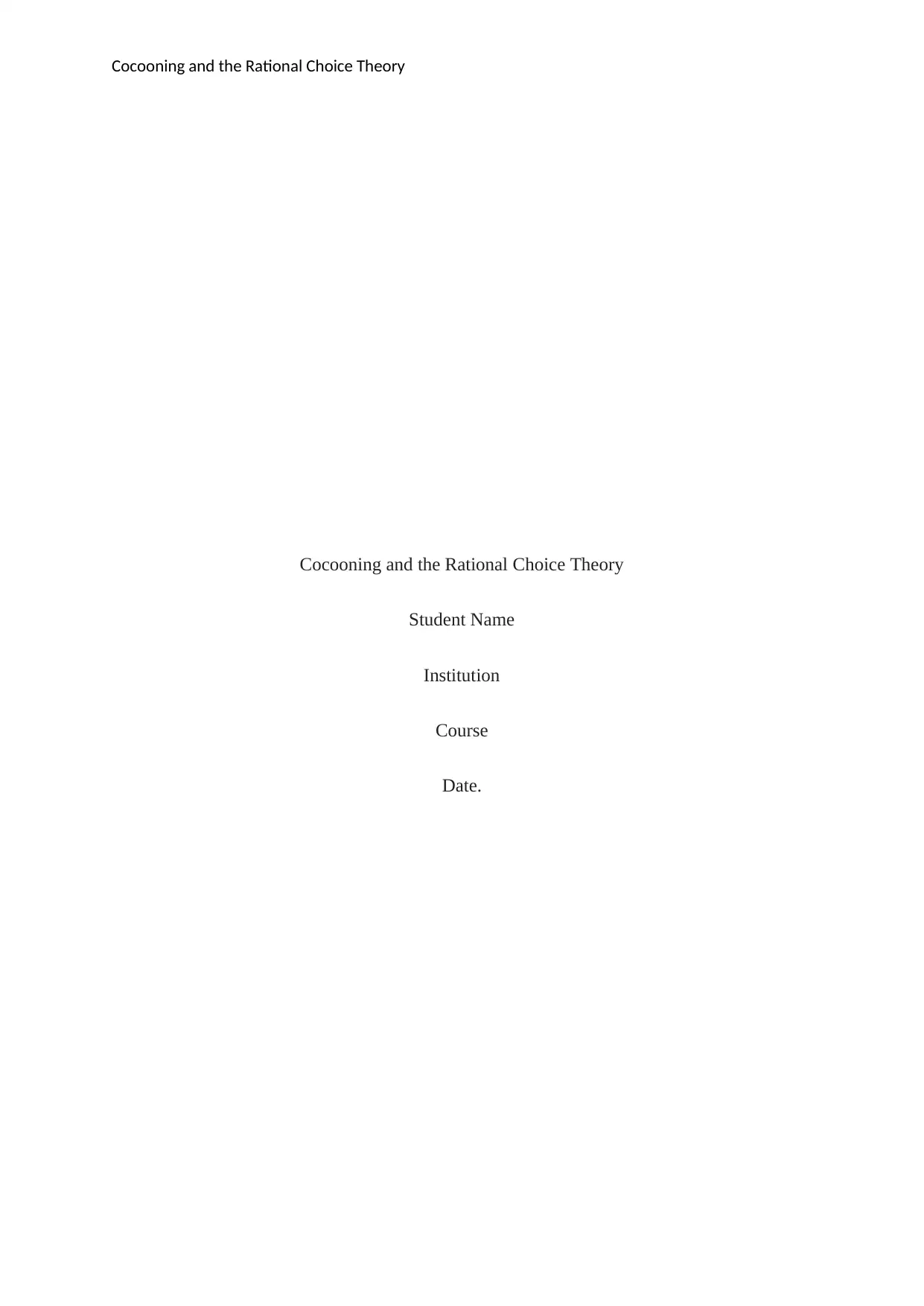
Cocooning and the Rational Choice Theory
Cocooning and the Rational Choice Theory
Student Name
Institution
Course
Date.
Cocooning and the Rational Choice Theory
Student Name
Institution
Course
Date.
Secure Best Marks with AI Grader
Need help grading? Try our AI Grader for instant feedback on your assignments.
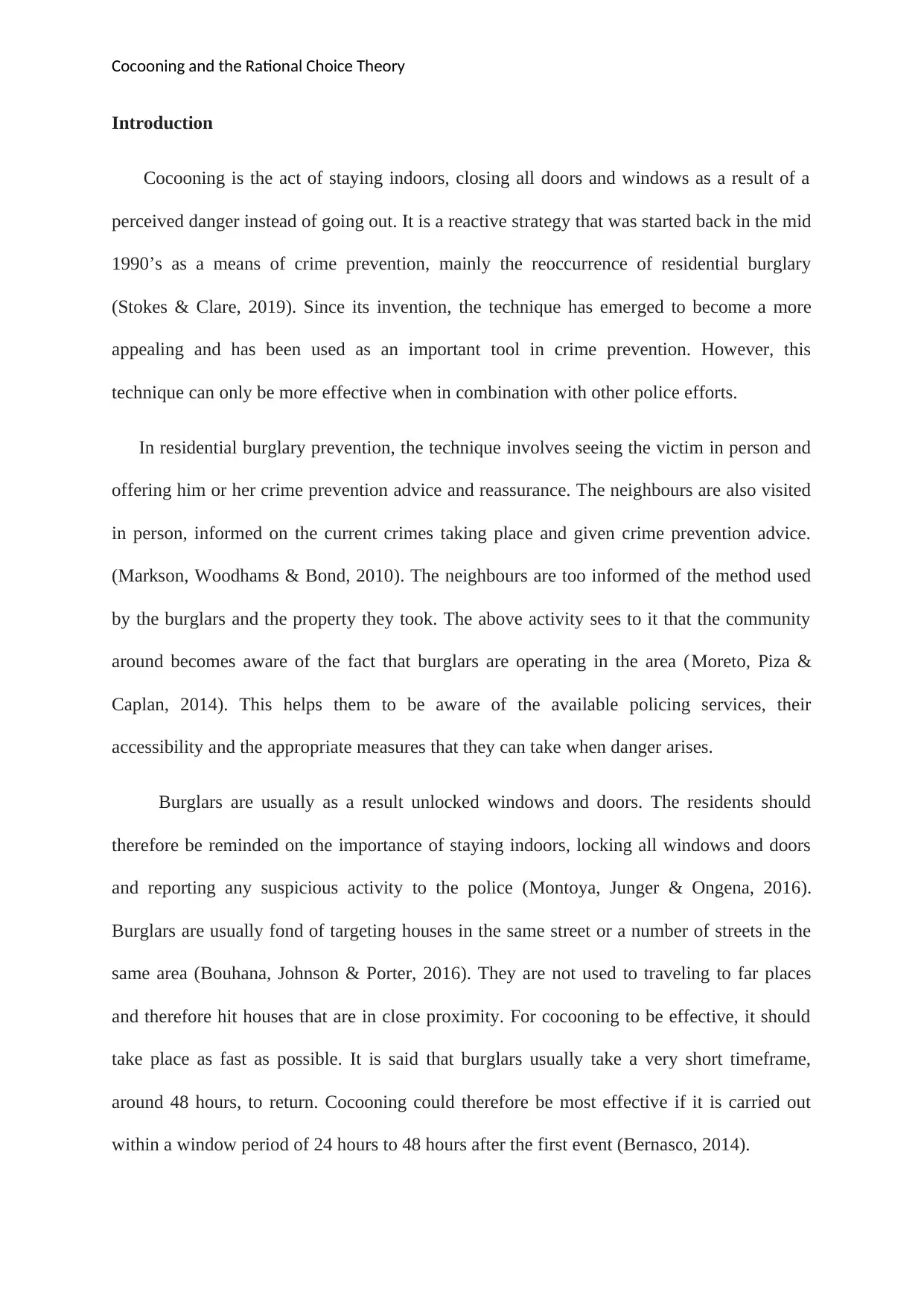
Cocooning and the Rational Choice Theory
Introduction
Cocooning is the act of staying indoors, closing all doors and windows as a result of a
perceived danger instead of going out. It is a reactive strategy that was started back in the mid
1990’s as a means of crime prevention, mainly the reoccurrence of residential burglary
(Stokes & Clare, 2019). Since its invention, the technique has emerged to become a more
appealing and has been used as an important tool in crime prevention. However, this
technique can only be more effective when in combination with other police efforts.
In residential burglary prevention, the technique involves seeing the victim in person and
offering him or her crime prevention advice and reassurance. The neighbours are also visited
in person, informed on the current crimes taking place and given crime prevention advice.
(Markson, Woodhams & Bond, 2010). The neighbours are too informed of the method used
by the burglars and the property they took. The above activity sees to it that the community
around becomes aware of the fact that burglars are operating in the area (Moreto, Piza &
Caplan, 2014). This helps them to be aware of the available policing services, their
accessibility and the appropriate measures that they can take when danger arises.
Burglars are usually as a result unlocked windows and doors. The residents should
therefore be reminded on the importance of staying indoors, locking all windows and doors
and reporting any suspicious activity to the police (Montoya, Junger & Ongena, 2016).
Burglars are usually fond of targeting houses in the same street or a number of streets in the
same area (Bouhana, Johnson & Porter, 2016). They are not used to traveling to far places
and therefore hit houses that are in close proximity. For cocooning to be effective, it should
take place as fast as possible. It is said that burglars usually take a very short timeframe,
around 48 hours, to return. Cocooning could therefore be most effective if it is carried out
within a window period of 24 hours to 48 hours after the first event (Bernasco, 2014).
Introduction
Cocooning is the act of staying indoors, closing all doors and windows as a result of a
perceived danger instead of going out. It is a reactive strategy that was started back in the mid
1990’s as a means of crime prevention, mainly the reoccurrence of residential burglary
(Stokes & Clare, 2019). Since its invention, the technique has emerged to become a more
appealing and has been used as an important tool in crime prevention. However, this
technique can only be more effective when in combination with other police efforts.
In residential burglary prevention, the technique involves seeing the victim in person and
offering him or her crime prevention advice and reassurance. The neighbours are also visited
in person, informed on the current crimes taking place and given crime prevention advice.
(Markson, Woodhams & Bond, 2010). The neighbours are too informed of the method used
by the burglars and the property they took. The above activity sees to it that the community
around becomes aware of the fact that burglars are operating in the area (Moreto, Piza &
Caplan, 2014). This helps them to be aware of the available policing services, their
accessibility and the appropriate measures that they can take when danger arises.
Burglars are usually as a result unlocked windows and doors. The residents should
therefore be reminded on the importance of staying indoors, locking all windows and doors
and reporting any suspicious activity to the police (Montoya, Junger & Ongena, 2016).
Burglars are usually fond of targeting houses in the same street or a number of streets in the
same area (Bouhana, Johnson & Porter, 2016). They are not used to traveling to far places
and therefore hit houses that are in close proximity. For cocooning to be effective, it should
take place as fast as possible. It is said that burglars usually take a very short timeframe,
around 48 hours, to return. Cocooning could therefore be most effective if it is carried out
within a window period of 24 hours to 48 hours after the first event (Bernasco, 2014).
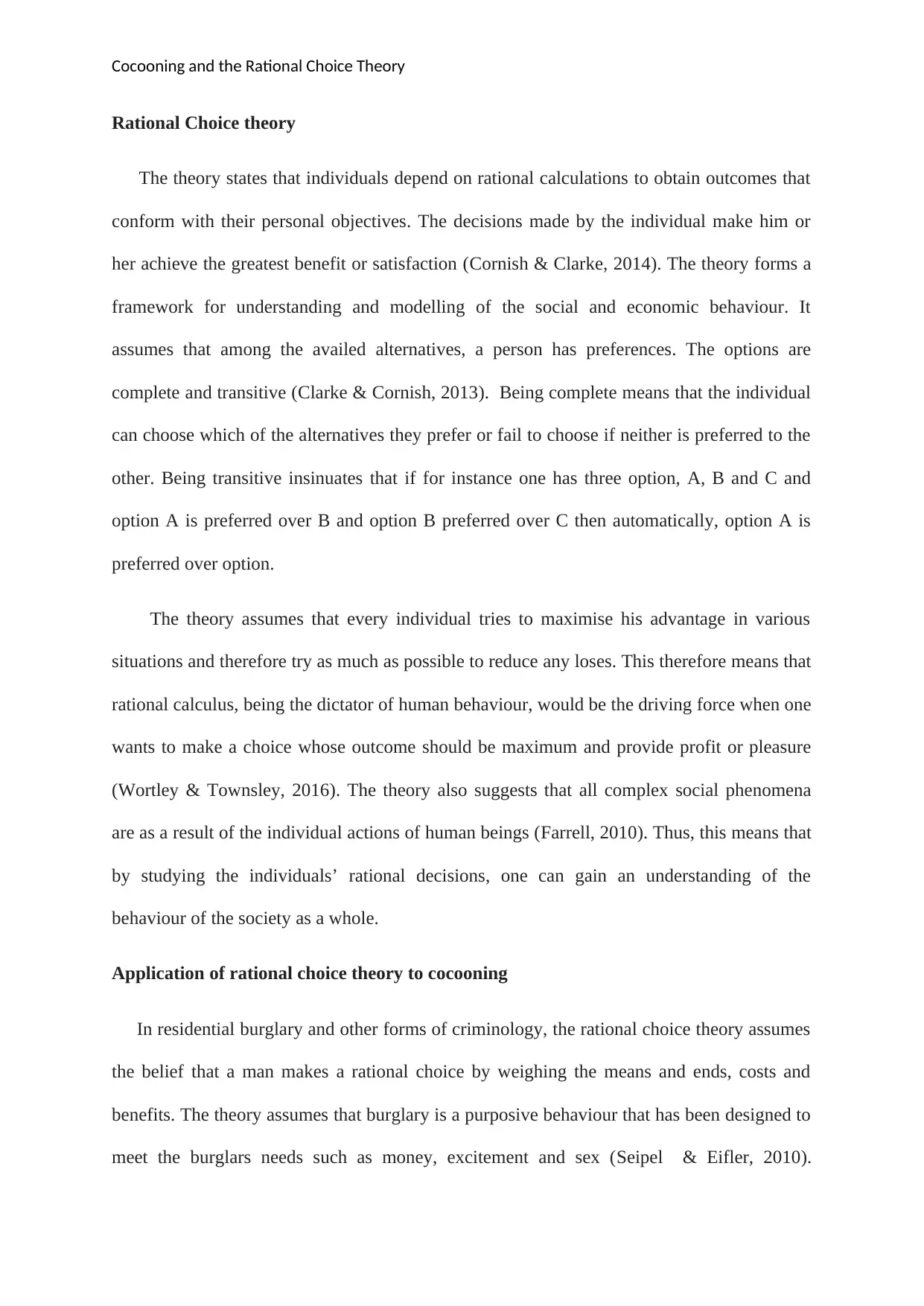
Cocooning and the Rational Choice Theory
Rational Choice theory
The theory states that individuals depend on rational calculations to obtain outcomes that
conform with their personal objectives. The decisions made by the individual make him or
her achieve the greatest benefit or satisfaction (Cornish & Clarke, 2014). The theory forms a
framework for understanding and modelling of the social and economic behaviour. It
assumes that among the availed alternatives, a person has preferences. The options are
complete and transitive (Clarke & Cornish, 2013). Being complete means that the individual
can choose which of the alternatives they prefer or fail to choose if neither is preferred to the
other. Being transitive insinuates that if for instance one has three option, A, B and C and
option A is preferred over B and option B preferred over C then automatically, option A is
preferred over option.
The theory assumes that every individual tries to maximise his advantage in various
situations and therefore try as much as possible to reduce any loses. This therefore means that
rational calculus, being the dictator of human behaviour, would be the driving force when one
wants to make a choice whose outcome should be maximum and provide profit or pleasure
(Wortley & Townsley, 2016). The theory also suggests that all complex social phenomena
are as a result of the individual actions of human beings (Farrell, 2010). Thus, this means that
by studying the individuals’ rational decisions, one can gain an understanding of the
behaviour of the society as a whole.
Application of rational choice theory to cocooning
In residential burglary and other forms of criminology, the rational choice theory assumes
the belief that a man makes a rational choice by weighing the means and ends, costs and
benefits. The theory assumes that burglary is a purposive behaviour that has been designed to
meet the burglars needs such as money, excitement and sex (Seipel & Eifler, 2010).
Rational Choice theory
The theory states that individuals depend on rational calculations to obtain outcomes that
conform with their personal objectives. The decisions made by the individual make him or
her achieve the greatest benefit or satisfaction (Cornish & Clarke, 2014). The theory forms a
framework for understanding and modelling of the social and economic behaviour. It
assumes that among the availed alternatives, a person has preferences. The options are
complete and transitive (Clarke & Cornish, 2013). Being complete means that the individual
can choose which of the alternatives they prefer or fail to choose if neither is preferred to the
other. Being transitive insinuates that if for instance one has three option, A, B and C and
option A is preferred over B and option B preferred over C then automatically, option A is
preferred over option.
The theory assumes that every individual tries to maximise his advantage in various
situations and therefore try as much as possible to reduce any loses. This therefore means that
rational calculus, being the dictator of human behaviour, would be the driving force when one
wants to make a choice whose outcome should be maximum and provide profit or pleasure
(Wortley & Townsley, 2016). The theory also suggests that all complex social phenomena
are as a result of the individual actions of human beings (Farrell, 2010). Thus, this means that
by studying the individuals’ rational decisions, one can gain an understanding of the
behaviour of the society as a whole.
Application of rational choice theory to cocooning
In residential burglary and other forms of criminology, the rational choice theory assumes
the belief that a man makes a rational choice by weighing the means and ends, costs and
benefits. The theory assumes that burglary is a purposive behaviour that has been designed to
meet the burglars needs such as money, excitement and sex (Seipel & Eifler, 2010).
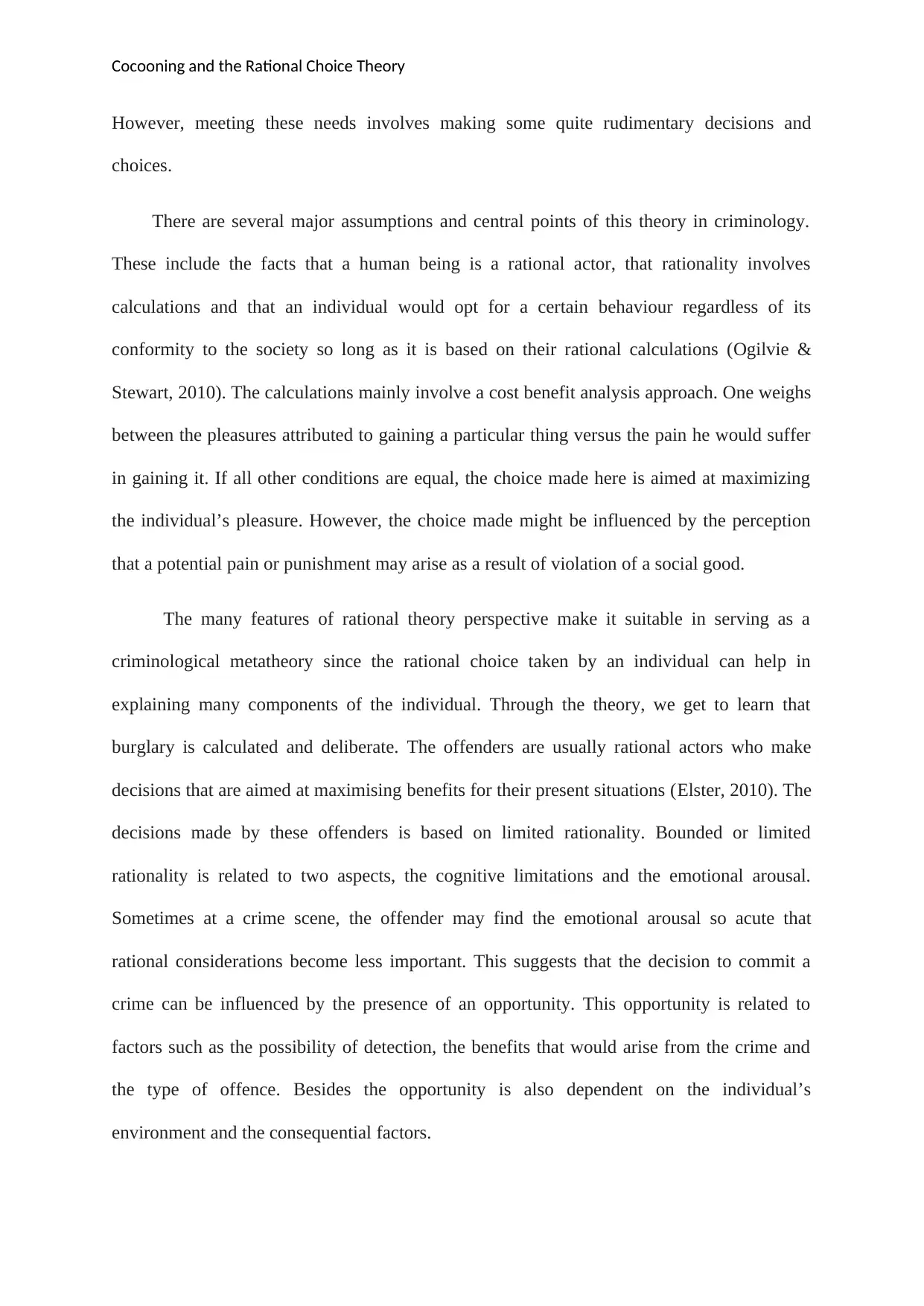
Cocooning and the Rational Choice Theory
However, meeting these needs involves making some quite rudimentary decisions and
choices.
There are several major assumptions and central points of this theory in criminology.
These include the facts that a human being is a rational actor, that rationality involves
calculations and that an individual would opt for a certain behaviour regardless of its
conformity to the society so long as it is based on their rational calculations (Ogilvie &
Stewart, 2010). The calculations mainly involve a cost benefit analysis approach. One weighs
between the pleasures attributed to gaining a particular thing versus the pain he would suffer
in gaining it. If all other conditions are equal, the choice made here is aimed at maximizing
the individual’s pleasure. However, the choice made might be influenced by the perception
that a potential pain or punishment may arise as a result of violation of a social good.
The many features of rational theory perspective make it suitable in serving as a
criminological metatheory since the rational choice taken by an individual can help in
explaining many components of the individual. Through the theory, we get to learn that
burglary is calculated and deliberate. The offenders are usually rational actors who make
decisions that are aimed at maximising benefits for their present situations (Elster, 2010). The
decisions made by these offenders is based on limited rationality. Bounded or limited
rationality is related to two aspects, the cognitive limitations and the emotional arousal.
Sometimes at a crime scene, the offender may find the emotional arousal so acute that
rational considerations become less important. This suggests that the decision to commit a
crime can be influenced by the presence of an opportunity. This opportunity is related to
factors such as the possibility of detection, the benefits that would arise from the crime and
the type of offence. Besides the opportunity is also dependent on the individual’s
environment and the consequential factors.
However, meeting these needs involves making some quite rudimentary decisions and
choices.
There are several major assumptions and central points of this theory in criminology.
These include the facts that a human being is a rational actor, that rationality involves
calculations and that an individual would opt for a certain behaviour regardless of its
conformity to the society so long as it is based on their rational calculations (Ogilvie &
Stewart, 2010). The calculations mainly involve a cost benefit analysis approach. One weighs
between the pleasures attributed to gaining a particular thing versus the pain he would suffer
in gaining it. If all other conditions are equal, the choice made here is aimed at maximizing
the individual’s pleasure. However, the choice made might be influenced by the perception
that a potential pain or punishment may arise as a result of violation of a social good.
The many features of rational theory perspective make it suitable in serving as a
criminological metatheory since the rational choice taken by an individual can help in
explaining many components of the individual. Through the theory, we get to learn that
burglary is calculated and deliberate. The offenders are usually rational actors who make
decisions that are aimed at maximising benefits for their present situations (Elster, 2010). The
decisions made by these offenders is based on limited rationality. Bounded or limited
rationality is related to two aspects, the cognitive limitations and the emotional arousal.
Sometimes at a crime scene, the offender may find the emotional arousal so acute that
rational considerations become less important. This suggests that the decision to commit a
crime can be influenced by the presence of an opportunity. This opportunity is related to
factors such as the possibility of detection, the benefits that would arise from the crime and
the type of offence. Besides the opportunity is also dependent on the individual’s
environment and the consequential factors.
Secure Best Marks with AI Grader
Need help grading? Try our AI Grader for instant feedback on your assignments.
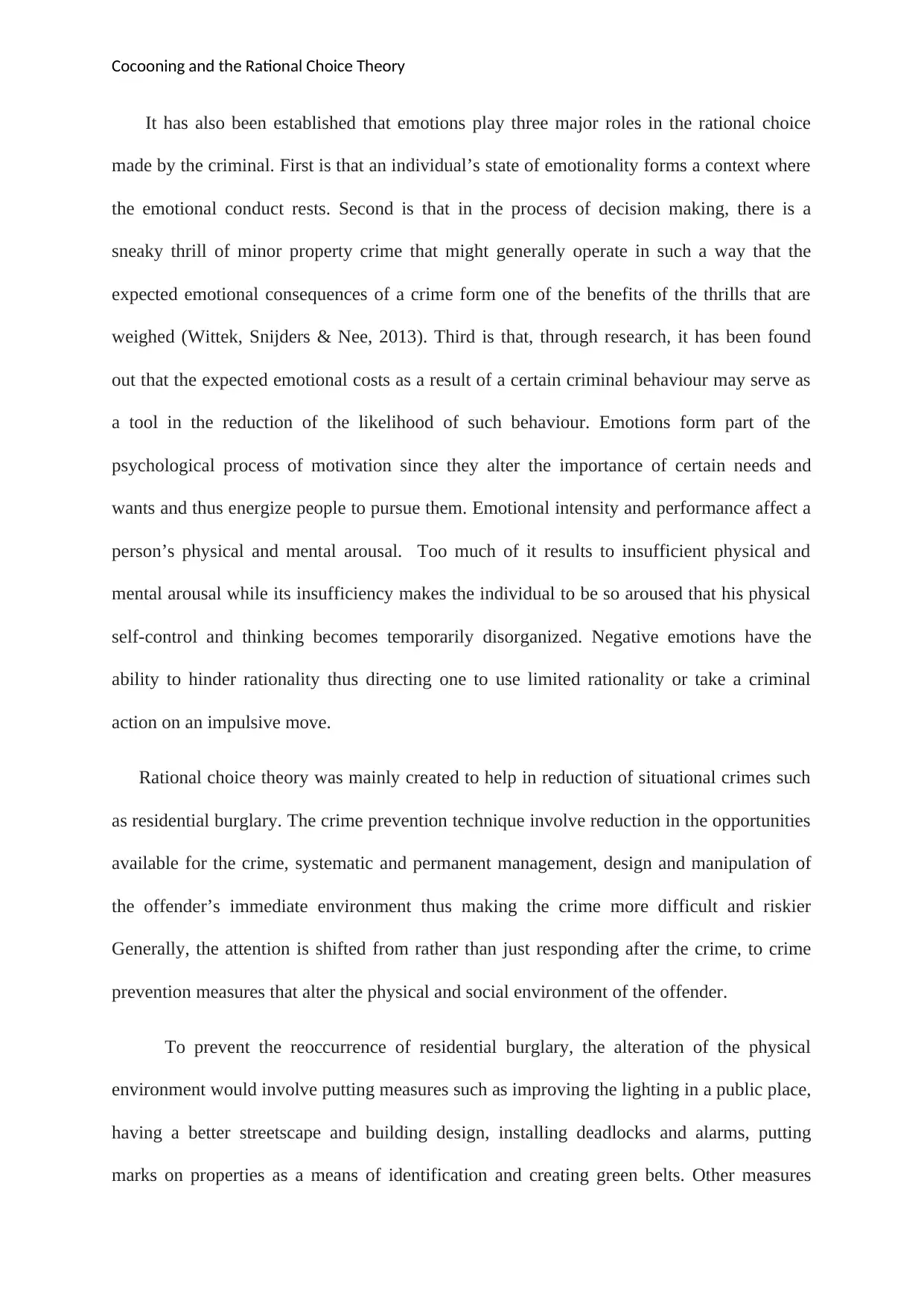
Cocooning and the Rational Choice Theory
It has also been established that emotions play three major roles in the rational choice
made by the criminal. First is that an individual’s state of emotionality forms a context where
the emotional conduct rests. Second is that in the process of decision making, there is a
sneaky thrill of minor property crime that might generally operate in such a way that the
expected emotional consequences of a crime form one of the benefits of the thrills that are
weighed (Wittek, Snijders & Nee, 2013). Third is that, through research, it has been found
out that the expected emotional costs as a result of a certain criminal behaviour may serve as
a tool in the reduction of the likelihood of such behaviour. Emotions form part of the
psychological process of motivation since they alter the importance of certain needs and
wants and thus energize people to pursue them. Emotional intensity and performance affect a
person’s physical and mental arousal. Too much of it results to insufficient physical and
mental arousal while its insufficiency makes the individual to be so aroused that his physical
self-control and thinking becomes temporarily disorganized. Negative emotions have the
ability to hinder rationality thus directing one to use limited rationality or take a criminal
action on an impulsive move.
Rational choice theory was mainly created to help in reduction of situational crimes such
as residential burglary. The crime prevention technique involve reduction in the opportunities
available for the crime, systematic and permanent management, design and manipulation of
the offender’s immediate environment thus making the crime more difficult and riskier
Generally, the attention is shifted from rather than just responding after the crime, to crime
prevention measures that alter the physical and social environment of the offender.
To prevent the reoccurrence of residential burglary, the alteration of the physical
environment would involve putting measures such as improving the lighting in a public place,
having a better streetscape and building design, installing deadlocks and alarms, putting
marks on properties as a means of identification and creating green belts. Other measures
It has also been established that emotions play three major roles in the rational choice
made by the criminal. First is that an individual’s state of emotionality forms a context where
the emotional conduct rests. Second is that in the process of decision making, there is a
sneaky thrill of minor property crime that might generally operate in such a way that the
expected emotional consequences of a crime form one of the benefits of the thrills that are
weighed (Wittek, Snijders & Nee, 2013). Third is that, through research, it has been found
out that the expected emotional costs as a result of a certain criminal behaviour may serve as
a tool in the reduction of the likelihood of such behaviour. Emotions form part of the
psychological process of motivation since they alter the importance of certain needs and
wants and thus energize people to pursue them. Emotional intensity and performance affect a
person’s physical and mental arousal. Too much of it results to insufficient physical and
mental arousal while its insufficiency makes the individual to be so aroused that his physical
self-control and thinking becomes temporarily disorganized. Negative emotions have the
ability to hinder rationality thus directing one to use limited rationality or take a criminal
action on an impulsive move.
Rational choice theory was mainly created to help in reduction of situational crimes such
as residential burglary. The crime prevention technique involve reduction in the opportunities
available for the crime, systematic and permanent management, design and manipulation of
the offender’s immediate environment thus making the crime more difficult and riskier
Generally, the attention is shifted from rather than just responding after the crime, to crime
prevention measures that alter the physical and social environment of the offender.
To prevent the reoccurrence of residential burglary, the alteration of the physical
environment would involve putting measures such as improving the lighting in a public place,
having a better streetscape and building design, installing deadlocks and alarms, putting
marks on properties as a means of identification and creating green belts. Other measures
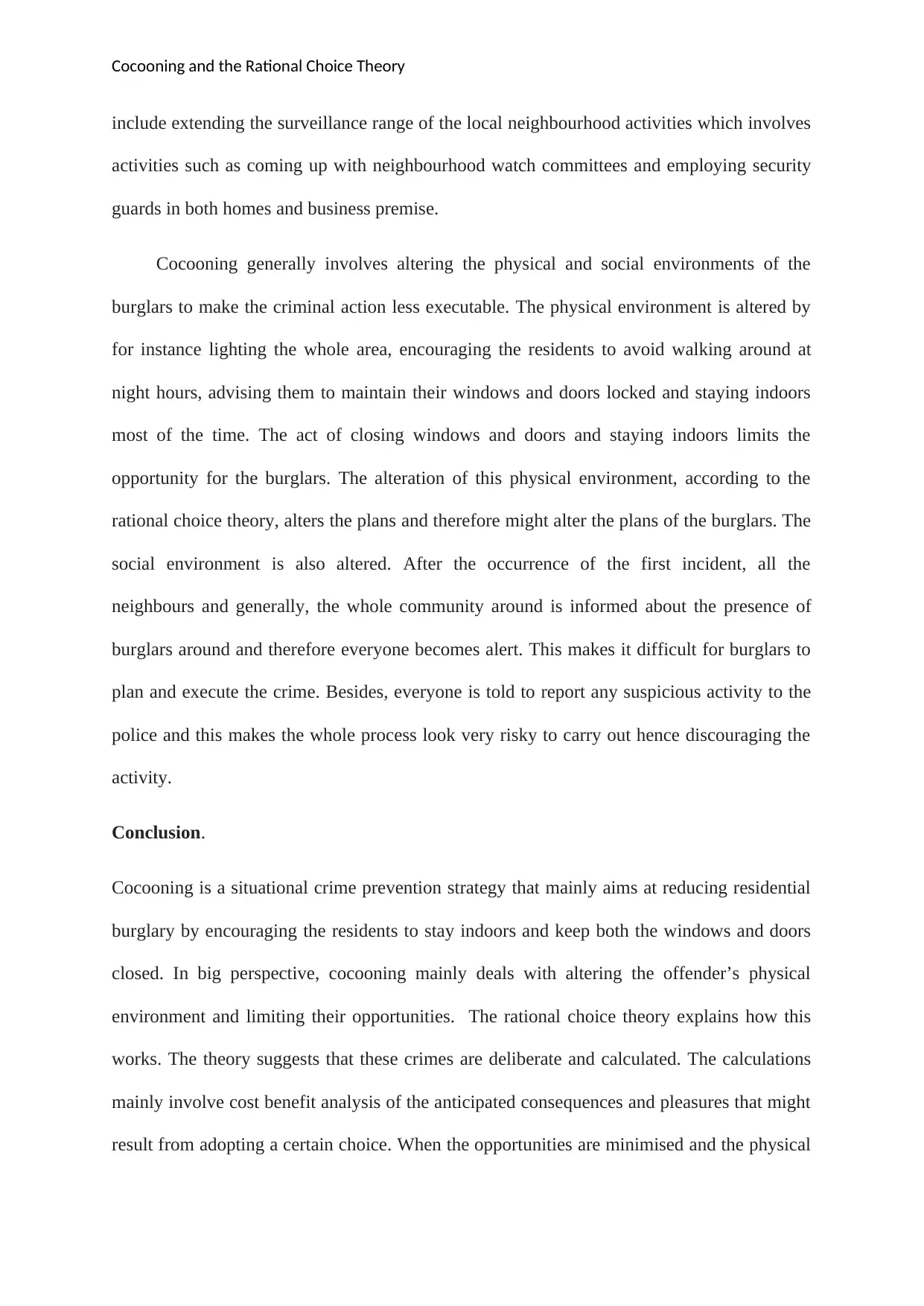
Cocooning and the Rational Choice Theory
include extending the surveillance range of the local neighbourhood activities which involves
activities such as coming up with neighbourhood watch committees and employing security
guards in both homes and business premise.
Cocooning generally involves altering the physical and social environments of the
burglars to make the criminal action less executable. The physical environment is altered by
for instance lighting the whole area, encouraging the residents to avoid walking around at
night hours, advising them to maintain their windows and doors locked and staying indoors
most of the time. The act of closing windows and doors and staying indoors limits the
opportunity for the burglars. The alteration of this physical environment, according to the
rational choice theory, alters the plans and therefore might alter the plans of the burglars. The
social environment is also altered. After the occurrence of the first incident, all the
neighbours and generally, the whole community around is informed about the presence of
burglars around and therefore everyone becomes alert. This makes it difficult for burglars to
plan and execute the crime. Besides, everyone is told to report any suspicious activity to the
police and this makes the whole process look very risky to carry out hence discouraging the
activity.
Conclusion.
Cocooning is a situational crime prevention strategy that mainly aims at reducing residential
burglary by encouraging the residents to stay indoors and keep both the windows and doors
closed. In big perspective, cocooning mainly deals with altering the offender’s physical
environment and limiting their opportunities. The rational choice theory explains how this
works. The theory suggests that these crimes are deliberate and calculated. The calculations
mainly involve cost benefit analysis of the anticipated consequences and pleasures that might
result from adopting a certain choice. When the opportunities are minimised and the physical
include extending the surveillance range of the local neighbourhood activities which involves
activities such as coming up with neighbourhood watch committees and employing security
guards in both homes and business premise.
Cocooning generally involves altering the physical and social environments of the
burglars to make the criminal action less executable. The physical environment is altered by
for instance lighting the whole area, encouraging the residents to avoid walking around at
night hours, advising them to maintain their windows and doors locked and staying indoors
most of the time. The act of closing windows and doors and staying indoors limits the
opportunity for the burglars. The alteration of this physical environment, according to the
rational choice theory, alters the plans and therefore might alter the plans of the burglars. The
social environment is also altered. After the occurrence of the first incident, all the
neighbours and generally, the whole community around is informed about the presence of
burglars around and therefore everyone becomes alert. This makes it difficult for burglars to
plan and execute the crime. Besides, everyone is told to report any suspicious activity to the
police and this makes the whole process look very risky to carry out hence discouraging the
activity.
Conclusion.
Cocooning is a situational crime prevention strategy that mainly aims at reducing residential
burglary by encouraging the residents to stay indoors and keep both the windows and doors
closed. In big perspective, cocooning mainly deals with altering the offender’s physical
environment and limiting their opportunities. The rational choice theory explains how this
works. The theory suggests that these crimes are deliberate and calculated. The calculations
mainly involve cost benefit analysis of the anticipated consequences and pleasures that might
result from adopting a certain choice. When the opportunities are minimised and the physical
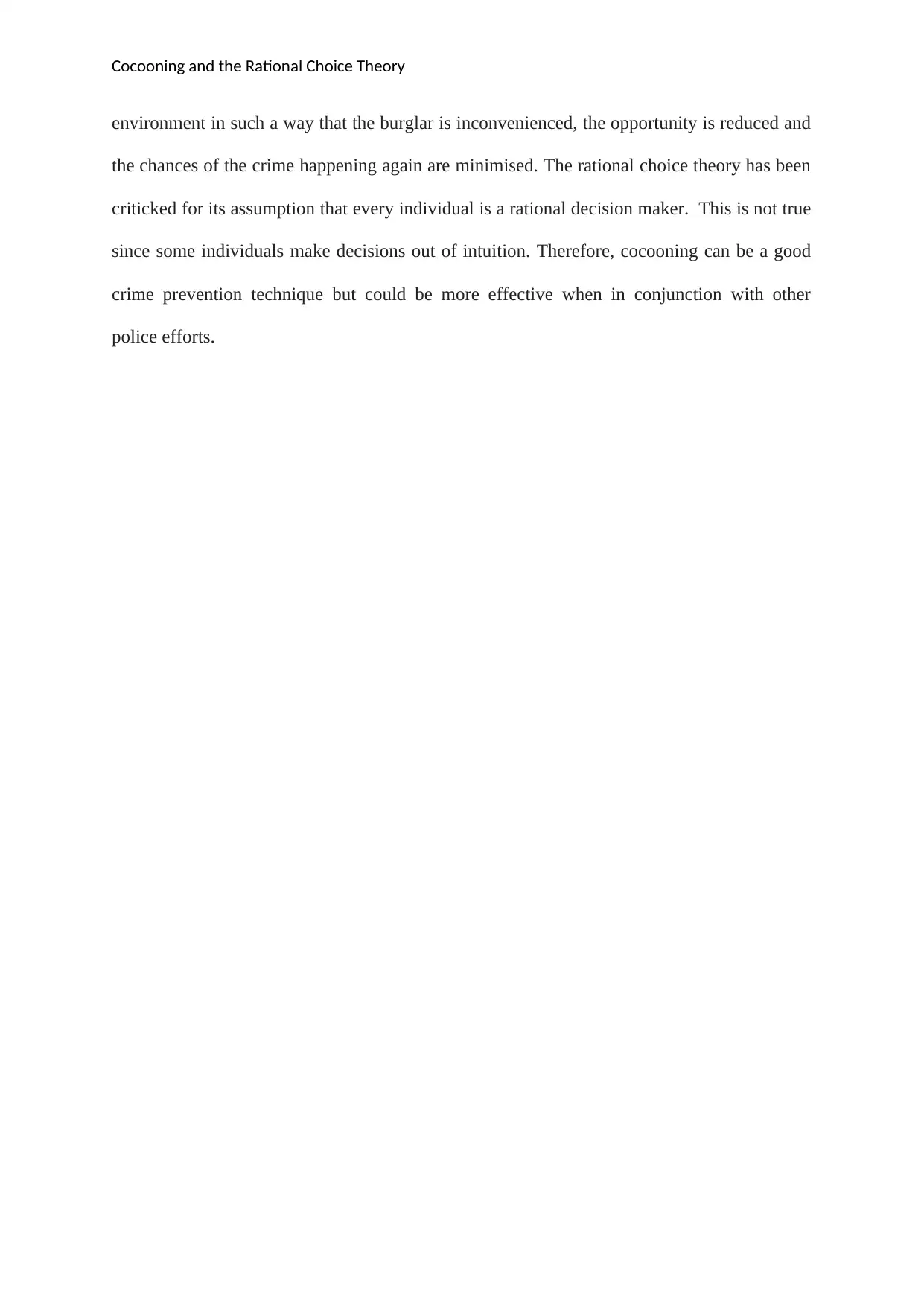
Cocooning and the Rational Choice Theory
environment in such a way that the burglar is inconvenienced, the opportunity is reduced and
the chances of the crime happening again are minimised. The rational choice theory has been
criticked for its assumption that every individual is a rational decision maker. This is not true
since some individuals make decisions out of intuition. Therefore, cocooning can be a good
crime prevention technique but could be more effective when in conjunction with other
police efforts.
environment in such a way that the burglar is inconvenienced, the opportunity is reduced and
the chances of the crime happening again are minimised. The rational choice theory has been
criticked for its assumption that every individual is a rational decision maker. This is not true
since some individuals make decisions out of intuition. Therefore, cocooning can be a good
crime prevention technique but could be more effective when in conjunction with other
police efforts.
Paraphrase This Document
Need a fresh take? Get an instant paraphrase of this document with our AI Paraphraser
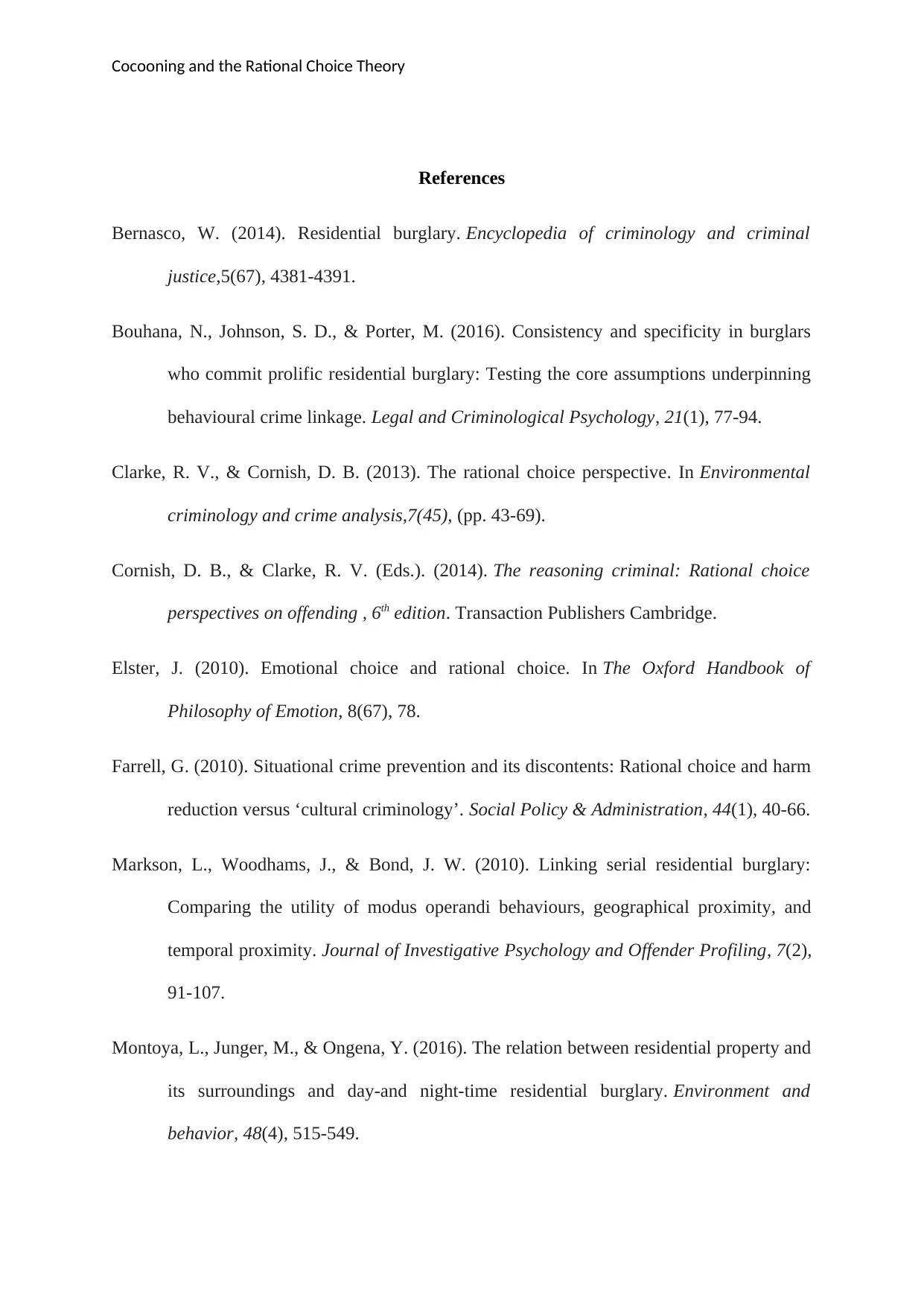
Cocooning and the Rational Choice Theory
References
Bernasco, W. (2014). Residential burglary. Encyclopedia of criminology and criminal
justice,5(67), 4381-4391.
Bouhana, N., Johnson, S. D., & Porter, M. (2016). Consistency and specificity in burglars
who commit prolific residential burglary: Testing the core assumptions underpinning
behavioural crime linkage. Legal and Criminological Psychology, 21(1), 77-94.
Clarke, R. V., & Cornish, D. B. (2013). The rational choice perspective. In Environmental
criminology and crime analysis,7(45), (pp. 43-69).
Cornish, D. B., & Clarke, R. V. (Eds.). (2014). The reasoning criminal: Rational choice
perspectives on offending , 6th edition. Transaction Publishers Cambridge.
Elster, J. (2010). Emotional choice and rational choice. In The Oxford Handbook of
Philosophy of Emotion, 8(67), 78.
Farrell, G. (2010). Situational crime prevention and its discontents: Rational choice and harm
reduction versus ‘cultural criminology’. Social Policy & Administration, 44(1), 40-66.
Markson, L., Woodhams, J., & Bond, J. W. (2010). Linking serial residential burglary:
Comparing the utility of modus operandi behaviours, geographical proximity, and
temporal proximity. Journal of Investigative Psychology and Offender Profiling, 7(2),
91-107.
Montoya, L., Junger, M., & Ongena, Y. (2016). The relation between residential property and
its surroundings and day-and night-time residential burglary. Environment and
behavior, 48(4), 515-549.
References
Bernasco, W. (2014). Residential burglary. Encyclopedia of criminology and criminal
justice,5(67), 4381-4391.
Bouhana, N., Johnson, S. D., & Porter, M. (2016). Consistency and specificity in burglars
who commit prolific residential burglary: Testing the core assumptions underpinning
behavioural crime linkage. Legal and Criminological Psychology, 21(1), 77-94.
Clarke, R. V., & Cornish, D. B. (2013). The rational choice perspective. In Environmental
criminology and crime analysis,7(45), (pp. 43-69).
Cornish, D. B., & Clarke, R. V. (Eds.). (2014). The reasoning criminal: Rational choice
perspectives on offending , 6th edition. Transaction Publishers Cambridge.
Elster, J. (2010). Emotional choice and rational choice. In The Oxford Handbook of
Philosophy of Emotion, 8(67), 78.
Farrell, G. (2010). Situational crime prevention and its discontents: Rational choice and harm
reduction versus ‘cultural criminology’. Social Policy & Administration, 44(1), 40-66.
Markson, L., Woodhams, J., & Bond, J. W. (2010). Linking serial residential burglary:
Comparing the utility of modus operandi behaviours, geographical proximity, and
temporal proximity. Journal of Investigative Psychology and Offender Profiling, 7(2),
91-107.
Montoya, L., Junger, M., & Ongena, Y. (2016). The relation between residential property and
its surroundings and day-and night-time residential burglary. Environment and
behavior, 48(4), 515-549.

Cocooning and the Rational Choice Theory
Moreto, W. D., Piza, E. L., & Caplan, J. M. (2014). “A plague on both your houses?”: Risks,
repeats and reconsiderations of urban residential burglary. Justice Quarterly, 31(6),
1102-1126.
Ogilvie, J., & Stewart, A. (2010). The integration of rational choice and self-efficacy
theories: A situational analysis of student misconduct. Australian & New Zealand
Journal of Criminology, 43(1), 130-155.
Seipel, C., & Eifler, S. (2010). Opportunities, rational choice, and self-control: On the
interaction of person and situation in a general theory of crime. Crime &
Delinquency, 56(2), 167-197.
Stokes, N., & Clare, J. (2019). Preventing near-repeat residential burglary through cocooning:
post hoc evaluation of a targeted police-led pilot intervention. Security Journal, 32(1),
45-62.
Wittek, R., Snijders, T. A., & Nee, V. (Eds.). (2013). The handbook of rational choice social
research ,5th edition. Stanford University Press Lyton.
Wortley, R., & Townsley, M. (Eds.). (2016). Environmental criminology and crime analysis,
7th edition. Oxford University Publish Oxford.
Moreto, W. D., Piza, E. L., & Caplan, J. M. (2014). “A plague on both your houses?”: Risks,
repeats and reconsiderations of urban residential burglary. Justice Quarterly, 31(6),
1102-1126.
Ogilvie, J., & Stewart, A. (2010). The integration of rational choice and self-efficacy
theories: A situational analysis of student misconduct. Australian & New Zealand
Journal of Criminology, 43(1), 130-155.
Seipel, C., & Eifler, S. (2010). Opportunities, rational choice, and self-control: On the
interaction of person and situation in a general theory of crime. Crime &
Delinquency, 56(2), 167-197.
Stokes, N., & Clare, J. (2019). Preventing near-repeat residential burglary through cocooning:
post hoc evaluation of a targeted police-led pilot intervention. Security Journal, 32(1),
45-62.
Wittek, R., Snijders, T. A., & Nee, V. (Eds.). (2013). The handbook of rational choice social
research ,5th edition. Stanford University Press Lyton.
Wortley, R., & Townsley, M. (Eds.). (2016). Environmental criminology and crime analysis,
7th edition. Oxford University Publish Oxford.
1 out of 9
Your All-in-One AI-Powered Toolkit for Academic Success.
+13062052269
info@desklib.com
Available 24*7 on WhatsApp / Email
![[object Object]](/_next/static/media/star-bottom.7253800d.svg)
Unlock your academic potential
© 2024 | Zucol Services PVT LTD | All rights reserved.
